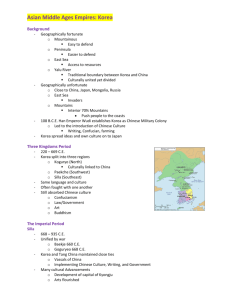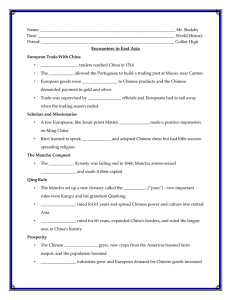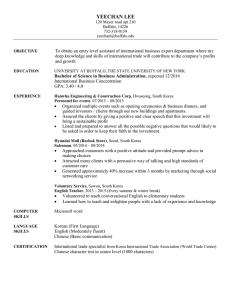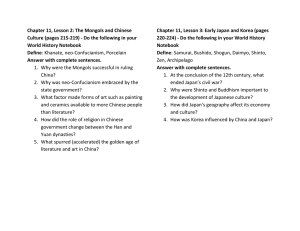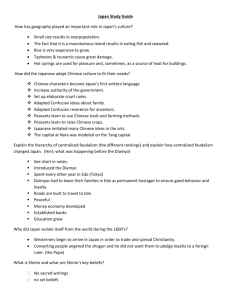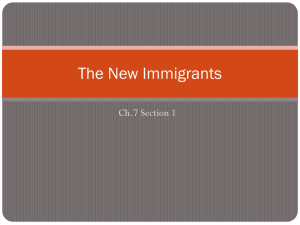Chapter 11 - East Asia (3D)
advertisement
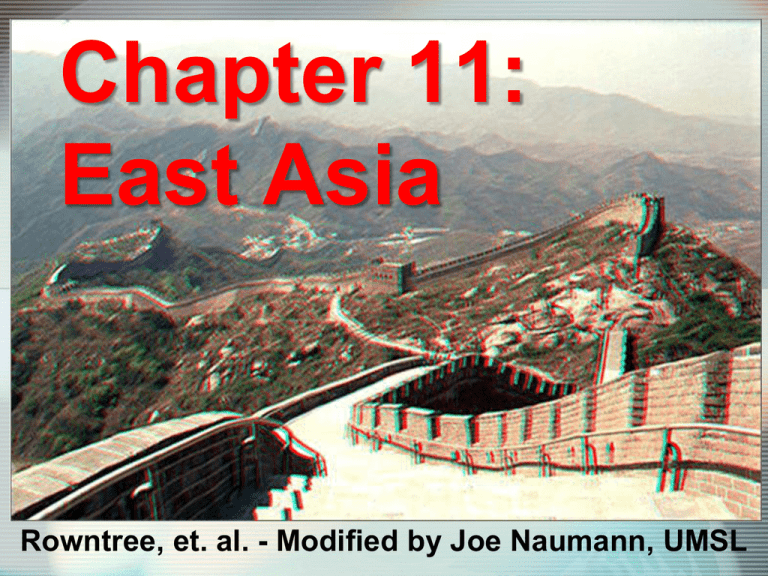
Chapter 11: East Asia Rowntree, et. al. - Modified by Joe Naumann, UMSL Chapter 11: East Asia (Fig. 11.1) Growing competition JAKOTA TRIANGLE – JApan south KOrea & TAiwan Learning Objectives – Learn about China, Japan, North and South Korea, and Taiwan – Understand the sources of cultural cohesiveness in E. Asia – Understand current and projected economic development in E. Asia – You should understand the following concepts and models: • Become familiar with the physical, demographic, cultural, political and economic aspects of East Asia – Understand the following concepts and models -Confucianism -Geomancy -Ideographic writing -Three Gorges Project -Marxism -Conurbation -Loess -JAKOTA Triangle Introduction – East Asia is the most populous region in the world – China is the most populous country, and the oldest continuous national culture – Eastern China is undergoing rapid economic development – China and Japan have been rivals from time to time – East Asia has experienced colonization, and has seen both internal and international conflict – Japan is extremely wealthy, but poverty may be found in parts of the region – East Asia is one of the core areas of the world economy and an emerging center of political power Relative Location CHINA’S RELATIVE LOCATION – AN HISTORICAL PERSPECTIVE • ISOLATION – Natural protective barriers – Distance – Inward looking (central kingdom) with minor incidences of cultural diffusion – Effects of one ocean • A history of emperors who restricted use of the coastline, except in local circumstances • Today the ocean is playing a major role in the economic (and cultural) transformation of coastal China. When China was a sea power Zheng He’s treasure ship compared to Columbus’ Santa Maria Environmental Geography: Resource Pressures in a Crowded Land • Flooding, Dam-Building, and Related Issues – China’s Yangtze River is an important resource (3rd largest volume) – The Three Gorges Controversy • Chinese government wants to dam the Yangtze (Chang Jiang) River with the largest hydroelectric dam in the world –Purpose: control floods & generate electricity –Problems: Will jeopardize animal species, flood a major scenic attraction, and displace up to 2 million people Three Gorges Dam Under Construction on the Chang Jiang (Yangtze River) Environmental Geography: Resource Pressures in a Crowded Land – Flooding in Northern China • Northern China Plain has long been plagued with floods and droughts –Worst floods caused by Huang He (Yellow River) –Huang He carries a huge sediment load (suspended clay, silt, sand); is the world’s muddiest river –Many dikes, but it’s still “the river of China’s sorrow” Environmental Geography: Resource Pressures in a Crowded Land (cont.) • Flooding, Dam-Building, Related Issues (cont.) – Erosion on the Loess Plateau • Huang He’s sediment burden from the Loess Plateau –Loess – a fine, wind-blown deposited material »Light tan color accounts for the old name, Yellow river and Yellow Sea –Loess is fertile, but vulnerable to erosion when plowed • Loess Plateau - one of the poorest parts of China LAND DEGREDATION Environmental Geography: Resource Pressures in a Crowded Land (cont.) • Other East Asian Environmental Problems – Forests and Deforestation • Little conservation of forests in China; much more in Japan • Reforestation programs have been unsuccessful • Substantial forests found in the far north and along Tibetan border • China may need to import wood products for development Environmental Issues in East Asia (Fig. 11.2) Environmental Geography: Resource Pressures in a Crowded Land (cont.) • Other East Asian Environmental Problems (cont.) – Mounting Pollution • China’s development causing water pollution, toxic waste dumping, and air pollution from the burning of high sulfur coal • Japan, Taiwan, South Korea have implemented stringent pollution controls and established pollution-generating industries outside of their countries to reduce pollution – Environmental Issues in Japan • Japan has a relatively clean environment – Environmental restrictions, cleanup and pollution exporting » Pollution exporting: Location of their dirtier factories elsewhere in the world Environmental Geography: Resource Pressures in a Crowded Land (cont.) • East Asia’s Physical Geography • Large area gives it large regional climatic variability • Similar latitude extent to U.S. • Climate of southern China like Florida; climate of northern China like Canada – Japan’s Physical Environment • Subtropical in the south and nearly subarctic in the north Climatic variations in the east and west • 85% of the country is mountainous – Japan’s forests come from favorable climate, history of forest conservation • Limited alluvial plains used for intensive agriculture – Kanto Plain, Kansai Basin, and Nobi Basin Physical Geography of East Asia (Fig. 11.6) PHYSIOGRAPHY Environmental Geography: Resource Pressures in a Crowded Land (cont.) • East Asia’s Physical Geography (cont.) – Taiwan’s Environment • Central and eastern regions are rugged and mountainous; west is dominated by an alluvial plain; mild winter climate; still has extensive forests – Chinese Environments • Southern China: rugged mountains and hills interspersed with lowland basins • Northern China: Gobi Desert, North China Plain, Loess Plateau – Korean Landscapes • Mountainous country with scattered alluvial basins • South Korea has better farmlands than North Korea Climate Map of East Asia (Fig. 11.7) Comparing Size & Latitude CLIMATE COMPARISON Cold Warm Dry Wet Population and Settlement: A Realm of Crowded Lowland Basins • Japanese Settlement and Agricultural Patterns – Japan’s Agriculture Lands • Largely limited to country’s coastal plains & interior basins • Rice, fruit, and vegetable cultivation – Settlement Patterns • 3 largest metropolitan areas: Tokyo, Osaka, and Nagoya • Population density: 870 per square miles • Mostly crowded in mainland industrial belt – Japan’s Urban-Agricultural Dilemma • Japanese cities located in agricultural lowlands • Restricted living space in urban areas • National importance of rice self-sufficiency Population Map of East Asia (Fig. 11.14) POPULATION COMPARISONS 285 300 250 MILLION S 200 150 100 50 0 127 50 23 JAPAN’S AGE DISTRIBUTION PERCENTAGE OF THE POPULATION AGE GROUP 1990 2025 0-14 Years 15-24 Years 25-64 Years 65+ Years 18.4% 15.4% 54.5% 11.7% 14.9% 11.6% 49.6% 23.9% ______________________________________________________ 100% 100% SOURCE: UNITED NATIONS WORLD POPULATION PROSPECTS 1990 (NEW YORK: UNITED NATIONS, 1991) DECLINING JAPANESE POPULATION Total fertility rates 2.06 1.66 1.65 1.44 1.24 0 0.5 1 1.5 2 Population and Settlement: A Realm of Crowded Lowland Basins (cont.) • Settlement and Agricultural Patterns in China, Taiwan, Korea • China is only 30% urban; Japan, Taiwan, Korea urban – China’s Agricultural Regions • Rice dominant in the south; wheat, millet, sorghum in the north • North China Plain is one of the most thoroughly anthropogenic landscapes in the world (anthropogenic landscape – one that has been heavily transformed by human activities) • Manchuria thoroughly settled; Loess Plateau thinly settled – Settlement and Agricultural Patterns in Korea and Taiwan • Korea densely populated (70 million); 1,150 per square mile • Taiwan is most densely; 22 million; 1,500 per square mil KOREA: NORTH-SOUTH CONTRASTS • NORTH KOREA – 55% of the land, 1/3 of the population, extremely rural – Antiquated state enterprises – Inefficient, non-productive agriculture – Limited trade – former Soviet Union and China • SOUTH KOREA – 45% of the land, 2/3s of the population, highly urbanized – Modern factories – Intensive, increasingly mechanized agriculture – Extensive trade – US, Japan, and Western Europe North South THE KOREAS • POPULATION 23,700,000 50,200,000 • GNP (BILLIONS) $ 21.3 $ 508.3 • GNP/CAPITA $ 920 $ 8,600 • AGRICULTURE RESTRICTIVE GOOD – (as % of GNP) 25 % 8% – (% work force) 36 % 21 % TAIWAN TAIWAN • Historical background: – A Chinese province for centuries – Colonized by Japan in 1895 – Returned to China > WWII – 1949 – Chinese Nationalists (supported by the US) fled from the mainland and established the Republic of China (ROC) • Territory - approximately 14,000 Square miles • Population – 23.7 million • 77% urbanized Taiwan & S. Korea (ISSUES AND CONCERNS) • Vulnerability to Global Market Fluctuations • Land Use Competition • Urban Problems • Environmental Degradation • Political Questions • Post Industrial Economy In China Agriculture Remains Important: Rice in south & wheat in North Population and Settlement: A Realm of Crowded Lowland Basins (cont.) • East Asian Agriculture and Resource Procurement in Global Context – Global Dimensions of Japanese Agriculture and Forestry • Japan is one of the world’s largest food importers • Imports wood products, oil, coal, and minerals • Japan’s basic resource dependency is unusual – The Global Dimensions of Chinese Agriculture • China’s agricultural self-sufficiency has been reduced by the following: – Rapid economic growth, changing food preferences, and loss of land to industrial and residential development Population and Settlement: A Realm of Crowded Lowland Basins (cont.) • Urbanization in East Asia • Early urbanization, but the region was overwhelmingly rural until end of World War II – Chinese Cities • Oldest cities were fortified; houses built around courtyards, narrow alleyways • Colonial period changed urban form, emphasized coastal cities • Beijing (13 million) – capital during the Manchu period (1644–1912) Population and Settlement: A Realm of Crowded Lowland Basins (cont.) • Urbanization in East Asia (cont.) – City Systems of Japan, and South Korea • South Korea noted for urban primacy –Urban primacy – the concentration of urban population in a single city • Japan displays a pattern of superconurbation –Superconurbation: Megalopolis; a huge zone of coalesced metropolitan areas –Tokyo, Yokohama, Osaka, Kobe, Kyoto make Megalopolis Cultural Coherence and Diversity: A Confucian Realm? • Unifying Cultural Characteristics –The Chinese Writing System • Ideographic writing: form of writing in which symbol (ideograph or character) represents primarily an idea or thing rather than a sound –Disadvantage: difficult to learn large number of characters –Advantage: speakers of different languages can use the same writing system Cultural Coherence and Diversity: A Confucian Realm? – Korean Modifications • In 1400s, Koreans implemented their own writing system – Japanese Modifications • Kanji: characters borrowed from China • Hiragana: Japanese syllabary, in which symbol represents a syllable (combination vowel and consonant sound, like RA, or MI, or KO) • Katakana: for spelling words of foreign origin Cultural Coherence and Diversity: A Confucian Realm? (cont.) • Unifying Cultural Characteristics (cont.) – The Confucian Legacy • Confucianism: the philosophy developed by Confucius has a strong influence on the region – Greater influence in China and Korea than in Japan • 551- 479 BC- took on spiritual proportions after his deathConfucianism • Focused on suffering of common folks in Zhou dynasty • Dates from 6th Century B.C. to foster social stability • Emphasized that human virtues, rather than godly connections, should determine a person’s place in society • Obedience to authority; authority figures must act in a caring manner; education also important Cultural Coherence and Diversity: A Confucian Realm? (cont.) • Teachings have dominated chinese life and thought for more than 20 centuries – Modern Role of Confucian Ideas • In early 1900s, lagging development in East Asia raised questions about value of Confucian ideas • Communism hasn’t been able to completely negate its influence in China • Today, economic growth suggest that Confucian support for education and social stability are an advantage • Variable development in the region points to middle ground CHINESE PERSPECTIVES • One of the world’s great culture hearths • Continuous civilization for over 4,000 years • View of China as the center of the civilized world • Eastern vs. Western bias • Inward looking • Closed society Cultural Coherence and Diversity: A Confucian Realm? (cont.) • Religious Unity and Diversity in East Asia – Mahayana Buddhism • Diffused to China from India by the second century A.D.; widespread throughout the region • Nonexclusive: may be followed by people professing faith in other religions • Simplifies quest for total enlightenment (nirvana) with beings who refuse divine union for themselves to help others spiritually Buddhist Temple Cultural Coherence and Diversity: A Confucian Realm? (cont.) • Religious Unity and Diversity in East Asia (cont.) –Shinto • Closely bound to Japanese nationality • Beliefs about harmony of nature and its connection to human existence • A place- and nature-centered religion Shinto Temple Shinto Bride & Groom Cultural Coherence and Diversity: A Confucian Realm? (cont.) • Religious Unity and Diversity in East Asia (cont.) – Taoism and Other Chinese Belief Systems • Rooted in nature worship • Related to Geomancy: feng shui; Chinese and Korean practice of designing buildings in accordance with spiritual powers that supposedly flow through the local topography – Minority Religions • Christianity: Less than 1% in China and Japan, but this equals millions; about 6 million in Korea, mostly Protestants • Islam: Several tens of millions of Muslims in China (Hui) – Secularism in East Asia • Confucianism (a philosophy) and Marxism support secularism • East Asia is one of the most secular regions in the world Cultural Coherence and Diversity: A Confucian Realm? (cont.) • Linguistic and Ethnic Diversity in East Asia – Language and National Identity in Japan • Japanese is not related to any other language – Possible connections to Korean, or the Altaic languages • Ainu in peoples in the north; otherwise a homogenous society – Minority Groups in Japan • Several Japanese dialects (most distinct on Ryukyu Islands) • Koreans, Chinese, and South Asians in Japan; face discrimination • Other immigrants came to Japan beginning in 1980s; but their status is uncertain – Chinese, southern Asians in construction – Philippines immigrants in entertainment, prostitution – 200,000 Brazilians of Japanese ancestry Language Geography of East Asia Cultural Coherence and Diversity: A Confucian Realm? (cont.) • Linguistic and Ethnic Diversity … (cont.) – Language and Identity in Korea • Koreans relatively homogenous; vast majority speak Korean • Korean diaspora: a scattering of a particular group of people over a vast geographical area – In China, Kazakhstan, hundreds of thousands in the U.S., Canada, Australia, New Zealand – Language and Ethnicity Among the Han Chinese • Complex, heterogenous, even in China proper (eastern half) • Han majority • Han languages (Sinitic): Mandarin, Cantonese (Yue), Fujianese, Shanghaiese (Wu) • Tonal (changed tone changes meaning) and monosyllabic (one syllable) languages ETHNIC GROUPS IN CHINA •Han Chinese •Zhuang •Uygur •Hiu •Yi •Tibetan •Miao •Manchu •Mongol •Buyi •Korean 91.9% 8.1% CHINESE LANGUAGE • Chinese is one of the world’s oldest active languages. • Spoken Chinese varies dialect to dialect (not mutually intelligible), although the characters (over 50,000) used to represent the language remain the same. • Since Chinese is written in characters rather than by a phonetic alphabet, chinese words must be transliterated so foreigners can pronounce them. THE PINYIN SYSTEM • Enabled language to be a centripetal force • Adopted in 1958 • Based on pronunciation of Chinese characters in northern mandarin • Established a standard form of language throughout the country PINYIN • Literally, “spell sounds” • Developed in the people’s republic of China • The most accepted system of Romanizing Chinese Chinese Bei Nan Xi Dong Jing Shan He Jiang Translation North South West East Capital Mountain River (in the north) River (in the south) Cultural Coherence and Diversity: A Confucian Realm? (cont.) • Linguistic and Ethnic Diversity … (cont.) – The Non-Han Peoples • Many of the remote upland districts are inhabited by nonHan people – Tribal: people who have a traditional social order based on autonomous village communities • Manchus in remote portions of Manchuria; other nonHans in the far south autonomous regions (designed to allow non-Han peoples to experience “socialist modernization” at a different pace from the rest of China – Language and Ethnicity in Taiwan • Tribal peoples who speak languages related to Indonesian • Taiwanese and Mandarin speakers; Taiwanese discouraged Cultural Coherence and Diversity: A Confucian Realm? (cont.) • East Asian Cultures in Global Context • Tension between isolation and international involvement – The Globalized Fringe • Capitalist countries of the region are characterized by vibrant cosmopolitan internationalism • English a common language; many study in the U.S., England • Cultural flows increasingly two-way • Japanese products worldwide (electronics, cars, anime) – The Chinese Heartland • History of internal orientation, except on southern coast • China began to liberalize, open its doors in the 1970s and ’80s • Urban popular culture beginning to emerge The Geopolitical Framework and Its Evolution: The Imperial Legacies of China and Japan • Cold War rivalries split East Asia • The Evolution of China • Original core was the North China Plain and Loess Plateau • China unified in 3rd Century B.C.; efforts to conquer Korea – The Manchu Ch’ing Dynasty • Manchu Dynasty in power 1644 to well into 19th century – The Modern Era • In 1800s, China failed to keep pace with technological progress, and the empire declined • British used opium in lieu of silver to buy Chinese goods, setting off the Opium Wars, resulting in colonization • China divided into colonial “Spheres of Influence” The Great Wall •Several walls were built over a long period •Protection from Mongol horsemen from the north – communication system •Monumental engineering feat – they claim it can be seen from orbit in space China’s Grand Canal: NorthSouth Transportation System •Centuriesold engineering feat that is being upgraded for greater use in the coastal growth zone now. 19th Century European Colonialism (Fig. 11.25) The Geopolitical Framework and Its Evolution: The Imperial Legacies of China and Japan (cont.) • The Rise of Japan • Japan emerged as a unified state in 7th century A.D. • Was divided several times between 1000 and 1580 A.D. – The Closing and Opening of Japan • Tokugawa Shogunate reunited Japan in 1600s, established an isolationist policy – Shogun: a military leader who theoretically remains under the emperor but who actually holds power • Meiji Restoration (1868): strengthened government and economy – The Japanese Empire • Period of modernization and military building – War with China, Russia; annexation of Korea – War with the U.S. occurred after Japanese efforts to unite East and Southeast Asia (“Greater East Asia Co-Prosperity Sphere”) The Geopolitical Framework and Its Evolution: The Imperial Legacies of China and Japan (cont.) • Postwar Geopolitics – Japan’s Revival • Territory reduced to four main Japanese islands and the Ryukyu Archipelago – The Division of Korea • Divided by the U.S. and the Soviet Union after Korean War – The Division of China • Mao Zedong and the communists vs. the nationalists (who favored an authoritarian, capitalist economy) – Communists victorious in 1949 – Nationalists fled to Taiwan The Geopolitical Framework and Its Evolution: The Imperial Legacies of China and Japan (cont.) • Postwar Geopolitics (cont.) – The Chinese Territorial Domain • Occupation of Tibet, Xinjiang, and Inner Mongolia • Paracel and Spratly islands • China reclaimed Hong Kong in 1997 • The Global Dimension of East Asian Geopolitics • End of Cold War and China’s economic growth shifted the balance of power in the region • Increasing military budget in China; China has world’s largest army, nuclear weapons, sophisticated missile technology • China’s human rights record • Improved relations between China and the U.S. Geopolitical Issues in East Asia (Fig. 11.24) Economic and Social Development: An Emerging Core of the Global Economy • Japan’s Economy and Society – Japan’s Boom and Bust • 1950s was beginning of the Japanese “economic miracle” – Use of cheap labor shifts from clothing and toys to more sophisticated goods • 1990s: economic slump caused by collapse of inflated real estate market • Japan still a core country, with global influence – Living Standards and Social Conditions in Japan • High standard of living, though a little lower than U.S. • Low unemployment, health care provided; low crime rates • Literacy high, infant mortality low, life-spans long JAPAN’S POST WWII TRANSFORMATION • 1945 –1952: Allied Occupation – – – – – – Economic reshaping Labor legislation Constitution Civil rights Land reform U.S. “Helping hand” policy JAPAN’S CORE AREA DEVELOPMENT INDICATORS • • • • • • LIFE EXPECTANCY - 2nd (22nd) INFANT MORTALITY - 1st (29th) GNP PER CAPITA - 3rd (6th) LITERACY RATE - 9th (6th) EDUCATIONAL RANK - 15th (2nd) HUMAN DEVELOPMENT - 3rd (2nd) – JAPAN VS (UNITED STATES) Economic and Social Development: An Emerging Core of the Global Economy (cont.) • Japan’s Economy and Society (cont.) – Women in Japanese Society • Limited opportunities for career advancement • Marriage and family are the expected role • Drop in marriage rate may be a response • The Newly Industrialized Countries – The Rise of South Korea • 1960s program of export-led economic growth in South Korea • Shift from inexpensive consumer goods to heavy industrial products to high-tech equipment • South Korean companies increasingly became multinational – involving more than one country Economic and Social Development: An Emerging Core of the Global Economy (cont.) • The Newly Industrialized Countries (cont.) – Contemporary South Korea • Anti-government student-led protests repressed in 1960s and ’70s • Middle class successfully pushed for democratization in late 1980s – Taiwan and Hong Kong (now part of China) • Both have higher per capita gross domestic product (GDP) levels than South Korea • Government-guided economic development in Taiwan • Hong Kong has a somewhat laissez-faire system: market freedom, with increased government control • Economies linked internationally THE JAKOTA TRIANGLE •CHARACTERISTICS –Great cities –Enormous consumption of raw materials –State-of-the-art industries –Voluminous exports –Global links –Trades surpluses –Rapid development •CHALLENGES –Social problems –Political uncertainties –Vulnerabilities Economic and Social Development: An Emerging Core of the Global Economy (cont.) • Chinese Development – China Under Communism • “Great Leap Forward” resulted in the death of 20 million • Cultural Revolution of the 1960s – expulsion of many to “re-education” camps – Toward a Postcommunist Economy • China seeks closer connections with the world economy • Experimenting with capitalism – Industrial Reform • China opened Special Economic Zones (SEZs) in which foreign investment was welcomed and state involvement is minimal • Economic growth is around 6-7% SPECIAL ECONOMIC ZONES • INVESTOR INCENTIVES • LOW TAXES • EASING OF IMPORT AND EXPORT REGULATIONS • SIMPLIFIED LAND LEASES • HIRING OF CONTRACT LABOR PERMITTED • PRODUCTS MAY BE SOLD IN FOREIGN MARKETS AND IN CHINA (UNDER CERTAIN RESTRICTIONS) • LOCATION WAS PRIME CONSIDERATION Coastal Development & Open Cities Selection • • • • • • SIZE OVERSEAS TRADING HISTORY LINKS TO “OVERSEAS CHINESE” LEVELS OF INDUSTRIALIZATION POOL OF LOCAL TALENT AND LABOR CONFINED TO COASTAL AREAS Economic Development: The Golden Coastline •From the east to the west, it’s less developed HONG KONG • MEANS “FRAGRANT HARBOR”- AN EXCELLENT DEEP WATER PORT • BOOMED DURING THE KOREAN WAR • 6 MILLION PEOPLE WITHIN 400 SQ MILES • ECONOMY IS LARGER THAN HALF OF THE WORLD’S COUNTRIES – Great benefit to China • 1 JULY 1997- BRITISH TRANSFERRED CONTROL TO CHINA– many businesses remained there • HONG KONG RENAMED XIANGGANG • ACQUIRED A NEW STATUS AS CHINA’S ONLY SPECIAL ADMINISTRATIVE REGION (SAR) Economic and Social Development: An Emerging Core of the Global Economy (cont.) • Chinese Development (cont.) – Social and Regional Differentiation • Chinese economic reforms resulted in social and regional differentiation (when certain groups and portions of a country prosper while others fail) – The Booming Coastal Region • Most of China’s economic benefits have flowed to the coastal region and Beijing – Interior and Northern China • China’s interior and northern portions have seen little economic expansion; Manchuria is a “rust belt Shanghai and the Yangtze River Click on this picture to see the Three Gorges video clip Industrial North: China’s Rust Belt •Formerly called Manchuria Economic and Social Development: An Emerging Core of the Global Economy (cont.) • Chinese Development (cont.) – Social Conditions in China • China has made large investments in medical care and education • Regional contrasts in social development, well-being – China’s Population Quandary • 1.2 billion people in China – Establishment of the “one child policy” – Gender imbalance, other unintended consequences – The Position of Women • Traditionally low position in Chinese society China’s Population Policy • Under Mao Zedong – no emphasis on reducing population growth rate. • Under Deng Xiaoping – Onechild policy per family China’s Demographics • • • • • • 1,249,100,000 (1998) 1,294,000,000 (2002) Annual natural increase 0.9% (1970s - 3%) Life expectancy: 69 (males), 73 (females) TFR 1.8 born/women (1997) Physiological density-3,594 people/sq mi – Only 10% of the land is arable and 80% of the population lives on this land • Distribution: western 2/3s is sparsely populated (minorities) Conclusions • East Asia united by culture and history • Internal ethnic tensions growing in China • Korea must manage the transition from low-wage exporter to high-wage technological powerhouse • Japan coping with its economic challenges End of Chapter 11: East Asia
